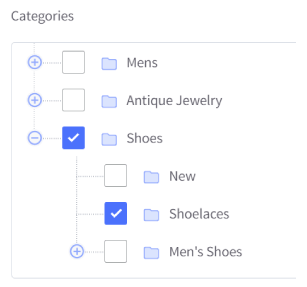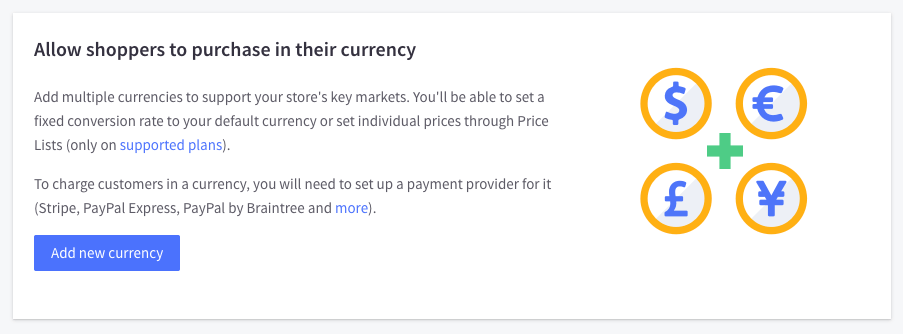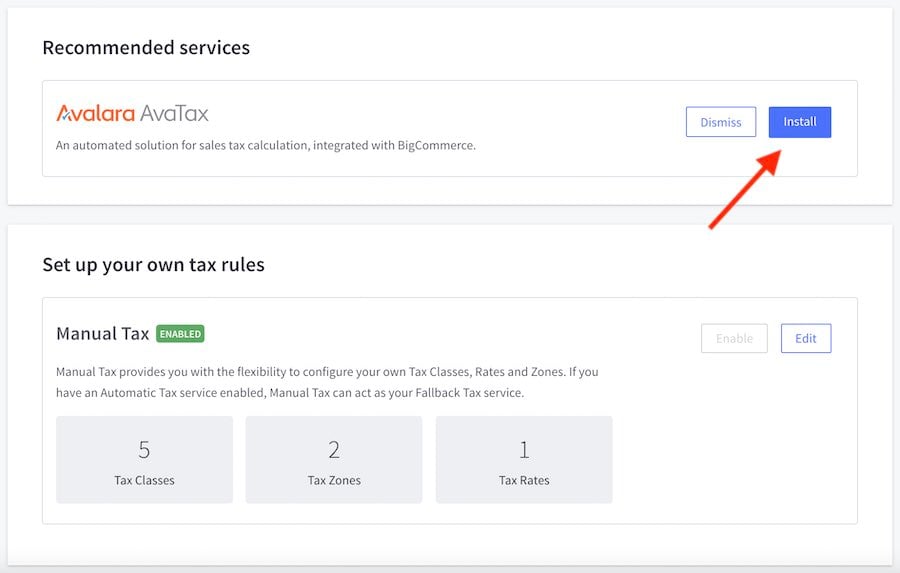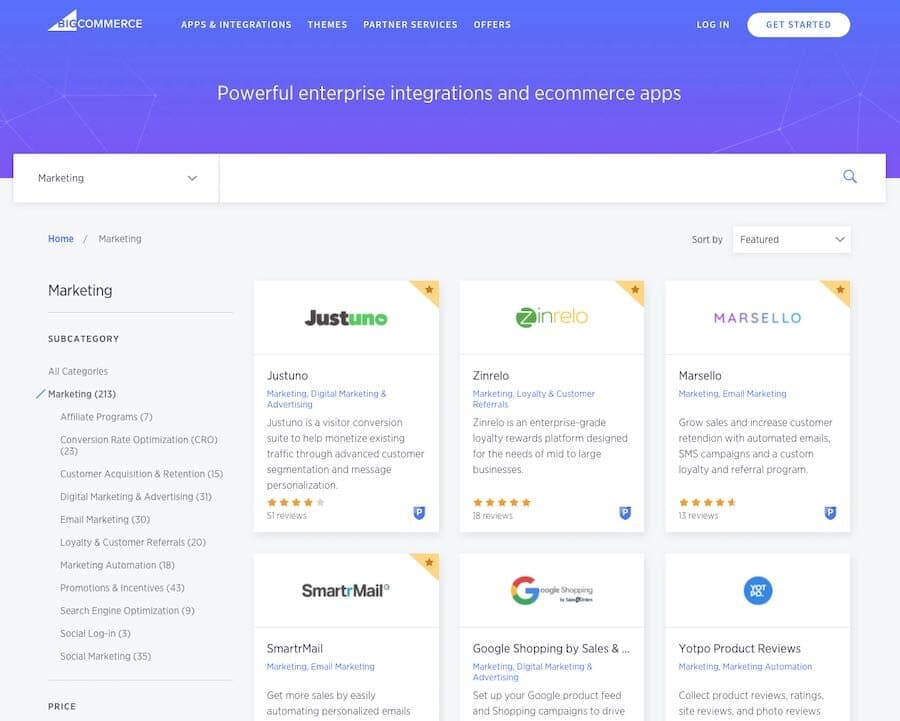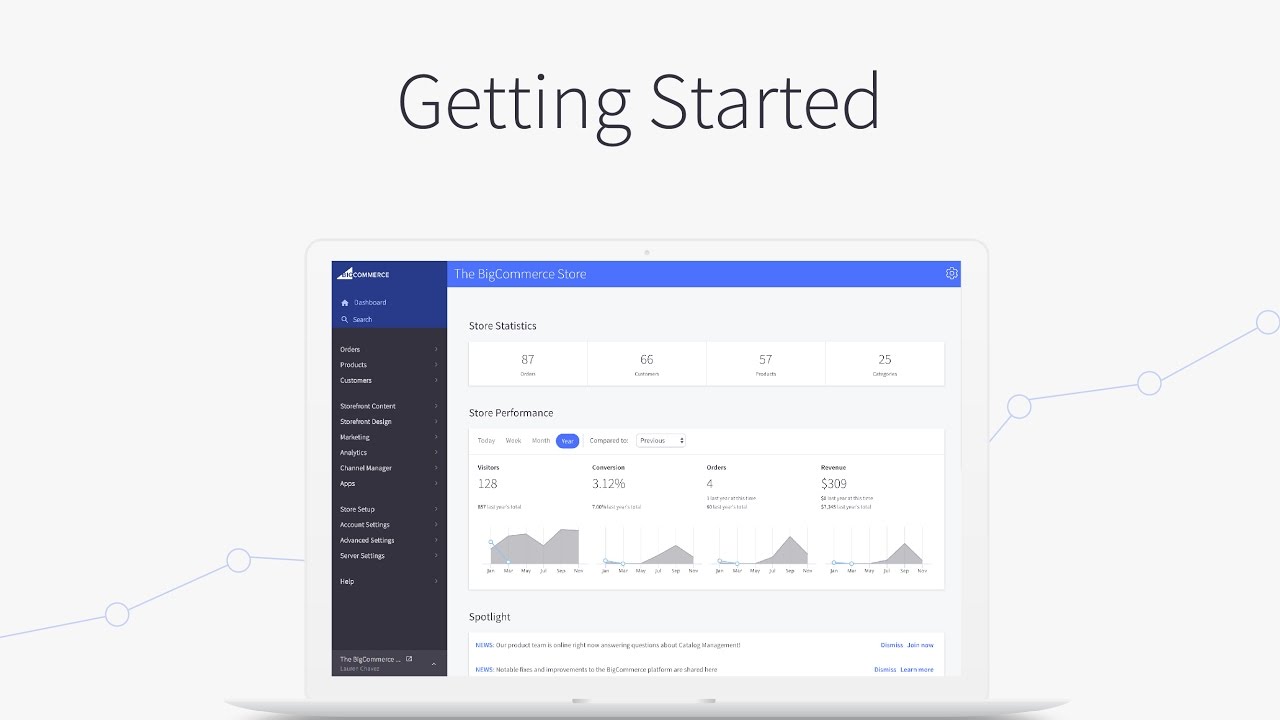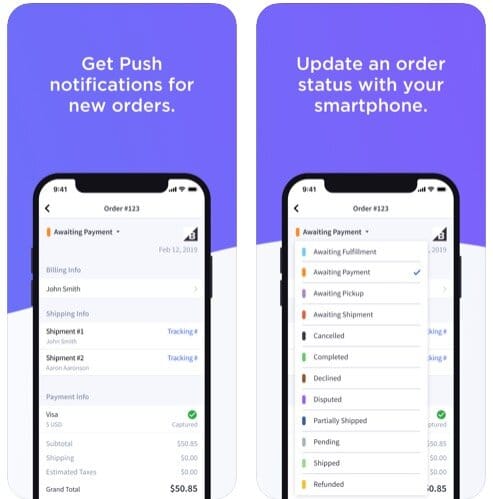BigCommerce (2022) — Key Pros and Cons of a Leading Store Builder
Also available in:
- Français
We follow a strict honesty policy. However, to fund our work, we use affiliate advertising links on this blog.
Inthis BigCommerce review, I take an in-depth look at one of the best-known ecommerce solutions currently available.
In the post, I’ll walk you through the key BigCommerce features. You’ll learn about all the BigCommerce pros and cons, and by the end of the article, you’ll have a much better idea of whether this ecommerce solution is the right one for your business — or whether you’d be better off with an alternative.
Let’s start with a simple question…what is BigCommerce?
What is BigCommerce?
BigCommerce is a paid-for, ‘hosted’ ecommerce solution that allows business owners to set up an online store and sell their products on the web.
‘Hosted’ means that BigCommerce runs on its own servers — you don’t have to buy web hosting or install anything on your computer to use it. As long as you have access to a web browser and the internet, you can build and manage your store from anywhere.
BigCommerce is a ‘software as a service’ (SaaS) solution — this means that you don’t own the software but instead pay a monthly fee to use it.
The platform comes with a range of customizable templates to help you design your online store; you can use it to sell either physical or digital goods; and there are also some tools provided to help you market your store.
BigCommerce is mainly aimed at people without much in the way of web design skills — but it also allows more tech-savvy users and developers to take things further, by tweaking the HTML and CSS of their stores.
As with all hosted online store and website building services — Shopify, Wix, Squarespace, Jimdo etc. — if BigCommerce were to shut down or change its feature set radically, you might find yourself in a position where you needed to migrate your store to another platform.
(Magento Go users can tell you all about that!).
But unless you are in a position to develop your own online store from scratch, you are in all likelihood going to end up using a hosted solution like BigCommerce anyway to run your store — and the good news is that it is one of the more established products of its kind out there.
According to BigCommerce, the company has 60,000 customers; 1,000+ employees, and a client roster that includes established brands like Ben and Jerry’s, Skull Candy and Paypal.
BigCommerce pricing
BigCommerce offers four monthly pricing plans:
- BigCommerce Standard: $29.95 per month
BigCommerce Plus: $79.95 per month
BigCommerce Pro: $299.95 per month
BigCommerce Enterprise: pricing varies, depending on your business requirements
A 10% discount is available for the ‘Plus’ and ‘Pro’ plans if you pay annually for them; and a 15-day free trial is also available. At time of writing, BigCommerce is also letting users of the free trial access a month’s free service if they upgrade to a paid plan at the end of their trial — you can learn more about this here.
The ‘Standard’, ‘Plus’ and ‘Pro’ plans are aimed at individuals and small businesses, and are part of the company’s “Essentials” range of products.
The Enterprise plan is geared more towards larger businesses and corporations (users with very high bandwidth and advanced selling requirements).
Core selling features
As we’ll see below, the exact features you get from BigCommerce depend very much on the plan you opt for, but important features common to all plans include:
the choice of 12 free templates
the ability to sell an unlimited number of physical or digital goods, in categories of your choosing and using shipping rates of your choosing
a drag-and-drop page builder
integrations with Paypal and a wide range of other payment gateways
unlimited staff accounts
blogging functionality
search engine optimization (SEO) tools
integration with a library of third-party apps
discount coupons and gift vouchers
product review functionality
the ability to tweak CSS and HTML
professional reporting
For a whistlestop tour of these, you can check out our video review of BigCommerce below; but you’ll learn more about the quality of all of these by reading this BigCommerce review in full.
So, let’s drill down into the key differences between each BigCommerce plan.
Differences between the BigCommerce plans
As you’d expect, how much functionality you get from BigCommerce depends on how much you’re prepared to pay for it.
Each plan offers a distinct set of features, which I’ll go through now.
Bigcommerce Standard
BigCommerce’s cheapest offering, the ‘standard’ plan, costs $29.95, which is roughly the same price as Shopify, Volusion, Wix and Squarespace’s entry level ecommerce plans.
That said it is, in general, a much more comprehensive starter plan than any of these, providing:
- a standalone online store
- the ability to sell an unlimited number of products
- unlimited bandwidth and storage
- unlimited staff accounts
- real-time shipping quotations
- gift cards and discount codes
- product reviews and ratings functionality
- multi-currency selling
- point of sale (POS) functionality (this lets you use a BigCommerce store to sell in a physical location)
- professional reporting
- AMP (accelerated mobile pages) functionality
As discussed above, this represents a lot of ecommerce bang for your buck — pretty much all the key ingredients of an online store are provided on BigCommerce’s standard plan — something that is not always the case with entry-level plans from other competing products.
Significantly, the BigCommerce Standard plan facilitates selling in multiple currencies, with automatic currency conversion available — again, this is fairly unique.
The main criticism you could make regarding the entry level BigCommerce plan is that abandoned cart saving features are not included with it.
An abandoned cart saver is an important piece of functionality, because you can use it to identify people who have stopped their purchase mid-way through, and automatically send them a reminder email encouraging them to complete the purchase.
The similarly-priced Shopify ‘Basic’ plan includes this, and it’s also available at a cheaper price point from Squarespace — so BigCommerce falls down a bit by comparison here.
There is an annual sales limit for BigCommerce Standard of $50,000.
BigCommerce Plus
Next up we have the ‘BigCommerce Plus’ plan.
In addition to the core functionality as you’ll find on the standard plan, it provides
- an abandoned cart saver tool
- a ‘persistent cart’ (this saves products to a customer’s cart irrespective of device used)
- stored credit cards (this allows your regular customers to save their card details on your store)
- customer grouping / segmentation.
With regard to the last feature mentioned above, customer grouping, this lets you divide customers into different segments, so that you can reward different customers based on activity and particular purchases. You could, for example, use this functionality to create a loyalty programme.
The annual sales limit for BigCommerce Plus is $180,000.
BigCommerce Pro
The next plan in the mix is ‘BigCommerce Pro’. With this plan, you don’t get a huge amount of extra functionality over BigCommerce Plus — but you do get a significantly increased sales limit.
This permits up to $400,000 in online sales, with an additional fee of $150 per month per $200k in sales.
One extra feature which is worth drawing attention to on this plan is Google Customer Reviews — a programme that lets you collect and display feedback from users who’ve made a purchase from your online store.
If you’ve enabled Google Customer Reviews, once a customer buys a product from your BigCommerce store, they will be asked if they’d like to review it on Google (after it’s been delivered).
If the customer indicates that they want to do this, Google will email them a survey after their order has arrived. The collected ratings are then displayed on your site (via an optional Google Customer Reviews badge), on Search Ads, and in Google Shopping.
The other main features that you gain on this plan are advanced product filtering and custom SSL via a third party.
BigCommerce Enterprise
Finally, there’s the BigCommerce “Enterprise” plan.
As the plan name suggests, it is geared towards corporate users that have very high volumes of sales (typically, over $1,000,000), and, accordingly, advanced selling requirements.
Features that are included on ‘Enterprise’ but not on the cheaper plans include:
- a multi-store creation feature – this lets you build lots of different versions of your online store, and change the content and currency settings to suit particular markets.
price lists (this allows you to create pricing rules based on customer groups — so different groups of customers see different product prices based on how you’ve segmented them)
unlimited API calls (BigCommerce’s API — ‘Application Programming Interface’ — allows developers to share data between your store and other apps, and the Enterprise plan doesn’t place any limits on how many times these ‘data sharing’ connections can be made. This makes it better suited to businesses that are expecting a high volume of traffic / API connections to their store)
- priority support (including API support)
BigCommerce consulting / account management
.
If you’re interested in using the Enterprise plan you will need to discuss your requirements with BigCommerce to establish pricing — the costs will reflect your business needs, but BigCommerce claims that they are cheaper than those for Shopify’s enterprise grade plan (this is called ‘Shopify Plus’ and typically comes in at around $2,000 per month).
You can generally expect a lot more support from BigCommerce if you purchase an Enterprise plan — in-depth support with data migration, setup, account management can all be facilitated.
The annuals sales limit for BigCommerce Enterprise is negotiable.
Now, let’s drill down into sales limits in a bit more depth.
Transaction fees and sales limits
A key question that many potential BigCommerce users ask is: “how much of a cut of my sales are they going to take?”
Well, the good news is that there are no transaction fees on any BigCommerce plan. This is in marked contrast to its key competitors.
However, you do have to pay credit card processing fees to the company you select to process payments. These will depend on the payment gateway you use (more on that in a moment).
The bad news, and as mentioned above, is that BigCommerce places a limits on your annual online sales.
These limits are as follows:
BigCommerce Standard: $50,000
BigCommerce Plus: $180,000
BigCommerce Pro: $400,000
BigCommerce Enterprise: negotiable.
(If you’re on the ‘BigCommerce Pro’ plan, you can increase the sales limit by paying $150 per month for every additional $200k in sales).
I contacted BigCommerce to see what happens if you breach these limits and the response was:
“There is an additional 1,000-2,000 order limit per plan that users are able to go over before being forced to upgrade. During this time users will receive notifications about upgrading their plan as they are over the limit. But we will not prevent additional orders from coming through until they exceed the additional 1,000-2,000 overage order provided.”
BigCommerce
I expect the limits issue won’t be a showstopper for most merchants — if your store is bringing in $400,000 per year, you probably won’t be moaning too much about having to pay an extra $150 per month for breaching the limit. But for some merchants they will be a bit of an annoyance.
Key competing products like Shopify or Squarespace don’t apply these sorts of limits — so it’s a bit of a ‘could do better’ here for BigCommerce.
Which BigCommerce plan represents the ‘sweet spot’?
For me, the best value BigCommerce plan is the $79 per month ‘Plus’ plan, because it gives you access to features that in most contexts will help you to sell considerably more products — an abandoned cart saver (essential!), persistent cart, and credit card storing. So long as you have a reasonably good flow of traffic to your site, these features will easily pay for themselves.
And, although I’d prefer not to see sales limits on any of the BigCommerce plans, the sales limit for this one is reasonably high: $180k.
For a limited period, BigCommerce are offering 1 month’s free service on this plan (in addition to the 15-day free trial). You can avail of this free trial and try out the ‘Plus’ plan here.
Payment gateways
There are two ways to accept credit card payments in BigCommerce.
The simplest thing to do is to use the default payment option for BigCommerce, Paypal powered by Braintree. Doing so makes for an easy payment gateway setup and gives you preferential Paypal rates for credit card transactions (which decrease as you go up BigCommerce’s pricing ladder).
The US rates are currently as follows:
BigCommerce Standard: 2.59% + 49c
BigCommerce Plus: 2.35% + 49c
BigCommerce Pro: 2.05% + 49c
BigCommerce Enterprise: 2.05% + 49c
These fees can be lower in other countries — for example, in the UK, rates start at 1.20% + 30p.
There’s also the option of using a third-party payment processor for your online store: these are called ‘payment gateways,’ and around 45 are available for BigCommerce, depending on your country of operation.
This number compares reasonably well with competing products. Squarespace only provides an integration with 2 payment gateways (Stripe and Paypal); Shopify, however, offers over 100.
Depending on the payment gateway provider you choose, you can expect to pay a monthly fee, a transaction fee, or both.
It’s important to note that these fees are not applied by BigCommerce but by the payment gateway provider in question.
(This contrasts positively with Shopify, which charges you transaction fees to use a third-party payment gateway).
Integrating a payment gateway with a hosted ecommerce solution like BigCommerce can occasionally be bit of a lengthy process, which involves setting up ‘merchant accounts’ with your chosen gateway provider and configuring them so that they work with your store.
It is still worth looking at the various fees involved with other payment gateway providers though — depending on what you sell and how much of it, using a different payment gateway may still be the best route for you to go down, even if it involves a bit more configuration time.
BigCommerce templates
BigCommerce offers a reasonably good selection of responsive templates that you can use for the design of your online store.
At time of writing, there are 12 free BigCommerce themes and 178 paid themes; each one contains a number of different variants, so there is quite is a lot to choose from.
Free BigCommerce themes
The free themes on offer are contemporary, professional in appearance and provide a good starting point for building an online store.
However, a few of them are very similar to each other, with the main differences simply involving color scheme. This is a particular issue with the free themes — although there are technically 12 available, it feels more like there are actually just five themes to choose from.
This means that in the theme department, BigCommerce arguably doesn’t provide quite so much value as other solutions, like Shopify (which provides 15 very distinct free themes, several of which come in multiple variants) or Squarespace (which provides around 140 bundled themes).
Paid-for BigCommerce themes
To extend your options here, you can consider purchasing one of the paid-for BigCommerce themes. These are fairly reasonably priced, starting out at $150 and going up to $300 (occasionally you can pick one up at a discounted rate — I’ve seen premium themes available for $99 when on sale).
Again, you’ll find that some of these are a bit too similar to each other to merit being classified as different themes, however.
Ultimately, you will be able to create a professional design for your BigCommerce store using either the free or premium themes — it’d just be good to see the range of themes extended a bit.
Using the themes
One key area where there could be an improvement made to the themes involves typefaces: the bundled font selection in most of the free themes is very small by comparison to those offered by competitors like Shopify and Squarespace — in some cases limiting you to just 3 or 4 web fonts (in addition to 8 regular ‘web safe’ / desktop ones).
Although adding another font is perfectly doable, it involves adding some code to your template file, which won’t appeal to all users.
It’s also a bit hard to hide certain site elements in BigCommerce templates — for example, when testing the ‘Vault’ theme for this BigCommerce review, I couldn’t find an obvious way to remove the search bar; in the ‘Fortune’ theme, I couldn’t hide the sidebar without resorting to adding some CSS.
On the plus side, all the free themes are fully responsive, meaning they’ll automatically display correctly on any device (mobile, tablet, desktop etc.); and significantly, they are AMP-enabled too (I discuss AMP — Accelerated Mobile Pages format — later on in this review).
Product options, variants and categories in BigCommerce
A particularly strong feature of BigCommerce is the way it handles product options and variants.
Unlike its rival Shopify, which only allows you to present users with three product options without resorting to coding or paying for third-party apps, BigCommerce lets you create a large number of product options (up to 250 per product).
BigCommerce’s product variant limit is generous too — you can present a product in up to 600 variants.Again for perspective, Shopify and Squarespace’s equivalent variant limits are 100 and 250 respectively.
So if you are selling products that come in a lot of different formats, BigCommerce may be a particularly good option for you. See the below video for more detail on how it all works.
Although BigCommerce is great when it comes to product options, it’s less impressive when it comes to product categories — whilst creating and editing them is straightforward enough, you have to assign them to individual products in quite a manual fashion.
It would be better — as is the case with some other leading online store builders, notably Shopify — if you could automatically categorize products based on product name or tags.
To be fair, you can use a ‘bulk edit’ tool to speed up the process a bit, but I prefer Shopify‘s ‘smart’ approach to product categorization.
BigCommerce’s abandoned cart saver feature
A BigCommerce feature worth singling out for praise is its abandoned cart feature – it’s arguably one of the best out there.
The tool allows you to create up to three automated emails to site visitors who go part of the way through the sales process only to leave your store without buying anything.
This has the potential to dramatically increase your revenue with little effort – other than the ‘one-off’ time investment in setting up the automated messages – being involved.
Setting up abandoned cart emails in Bigcommerce.
It’s important to note however that the abandoned cart saver functionality only comes with BigCommerce’s ‘Plus’, ‘Pro’ and ‘Enterprise’ plans. This makes obtaining this functionality a bit more expensive than from some competing products.
That said, the BigCommerce abandoned cart saver is more flexible than the equivalent offerings from its key competitors — most of them limit the number of automated emails to one, whereas BigCommerce lets you send three follow-ups. So there may be some justification for the higher price.
In my experience, abandoned cart saver functionality usually pays for itself, and if you are confident of receiving a large number of visits to your site, purchasing a BigCommerce plan featuring the abandoned cart saver makes a lot of sense
You typically get more sales if you sell in the currency used by your site visitors.
So, if you’re selling in multiple countries, it’s a good idea to let your potential customers choose their own currency (or, better still, present products in your site visitors’ currency automatically).
The really good news is that with BigCommerce’s free themes, you get a very good multi-currency solution out of the box — one that facilitates automatic currency conversion based on IP address.
If you’re using a paid-for template, you may need to use a third-party app to facilitate multi-currency — Bold Multi-Currency is a good option.
But overall, BigCommerce scores highly when it comes to multi-currency selling — some competing solutions don’t offer this functionality at all (i.e., Squarespace) and others don’t provide fully automatic currency conversion unless you use an app or on an expensive enterprise-level plan (Shopify being a key example).
For me, this multi-currency functionality is one of the strongest arguments for choosing BigCommerce over a competing ecommerce solution.
Selling in multiple languages with BigCommerce
BigCommerce doesn’t have any built-in multilingual capabilites; however, you can still sell in multiple languages using the platform, thanks to an integration with the translation app Weglot.
The BigCommerce + Weglot approach brings both advantages and disadvantages. On the plus side, you can offer your site in up to 100+ languages; and the translations are automatic, with the choice to manually edit them.
(The integration has also been well received by BigCommerce users, scoring a 4.5 out of 5 score in the BigCommerce apps marketplace).
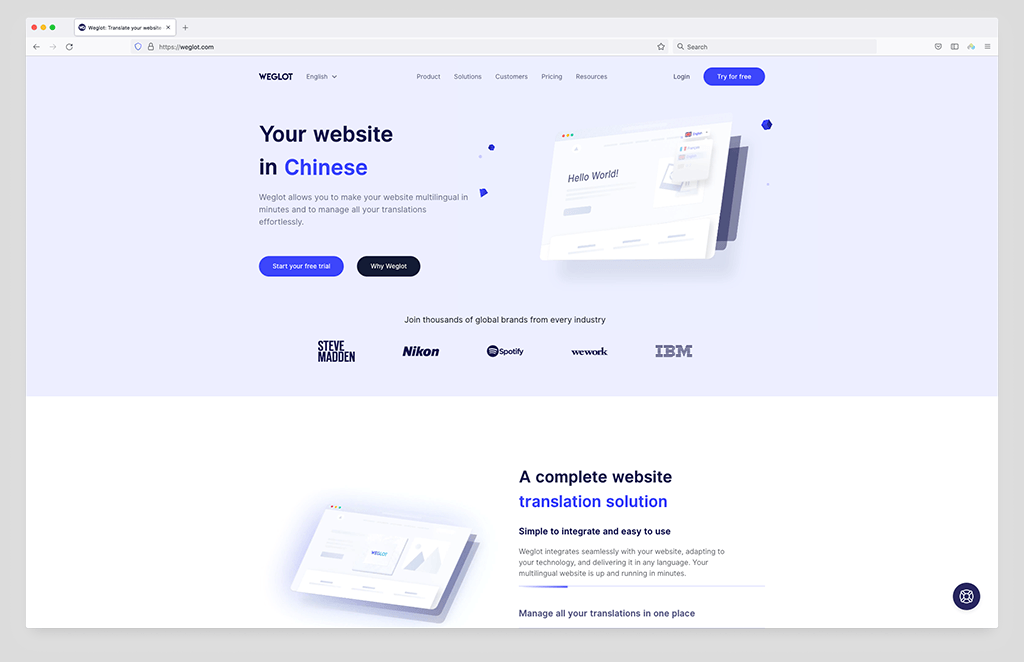
On the down side, you will need to pay extra for the Weglot app on top of your BigCommerce fees — between $21 and $230 depending on your needs.
And, machine translations, whilst improving all the time, are not usually as good as those provided by an experienced human translator.
Dropshipping with BigCommerce
Many potential BigCommerce merchants will be interested to learn how it handles dropshipping.
Dropshipping is a selling model where you don’t keep what you’re selling in stock. Instead, you take an order, send its details to a supplier, and they send the goods to your customer.
The advantage of this model is that you don’t need much start-up capital, as there’s no need to purchase any stock before you start selling.
The disadvantage is that the low start-up costs mean that there a lot of people doing it, and it ends up being quite a competitive business area.
You can use BigCommerce to dropship, but in order to do so, you’ll need to install a third-party app from BigCommerce’s app store (of which more in a moment) to facilitate it.
There are quite a few apps available to help you dropship with BigCommerce, with key ones including:
Ali-Express Dropshipping
Spocket
- Wholesale2B
- Inventory Source
- Printful
These apps vary in price to use, with free trials being available for some of them.
Point of sale functionality in BigCommerce
A nice feature of BigCommerce is that it doesn’t just let you run an online store — it can facilitate selling at ‘point of sale’ (POS) too.
Thanks to some integrations with various POS providers — including Square, Clover, Hike, Zettle, ConnectPOS and Vend — you can take payment and sync inventory when selling from a physical location (such as a store, market stall, event etc.).
You’ll need to research each of the available providers carefully to ensure you find the right one for your needs, but it’s good that BigCommerce offers a few options on this front.
Other competing ecommerce solutions either don’t offer POS at all — or are more restrictive in terms of what countries they can be used in, or the hardware and software options that are available.
File uploads and custom fields
Merchants who need to capture text to complete an order — for example jewellers who need personalized text for an engraving, or printers who need their customers to supply a JPG of a logo for a t-shirt — will find BigCommerce’s approach to custom fields and file uploads particularly good.
Creating custom fields and capturing data using them is really straightforward in BigCommerce — you simply find the relevant product, create your custom field, name it and then your site users will be able to enter information into it at the point of purchase.

Similarly, it’s really easy to allow your users to upload a file — again, it’s just a case of editing your product so that it contains an ‘upload file’ option.
Your customers will then be able to upload a file — up to a generous 524MB in size — when they purchase that product.
This functionality is implemented considerably better on BigCommerce than some competing products.
For example, while Shopify allows you to create custom fields and give users the option to upload files, it’s a fiddly process involving adding ‘line item properties’ to your code.
Squarespace allows you to create a custom field easily enough, but doesn’t facilitate file uploads.
So all in all, a thumbs-up for BigCommerce in this area.
Tax rules and VAT MOSS
Automatic tax calculation
One of the challenges of creating an online store is that you can end up selling goods in jurisdictions with differing tax rates — something that needs to be reflected in the pricing of your products.
Thankfully, BigCommerce allows you to apply tax rates automatically, which is a huge time saver. You will however need to research and install a third-party app to facilitate this — options include Avalara, Vertex, Taxjar and TaxCloud — so you can expect some additional costs. You’ll also need to check that your chosen app supports the country you’re based in.
Digital goods and the European Union
If you intend to sell digital products to European Union consumers with BigCommerce, and expect to raise over €10,000 a year in revenue from doing so, you’ll need to familiarize yourself with something called VAT MOSS (this is short for ‘VAT Mini One Stop Shop’).
VAT MOSS requires you to apply country-specific rates of VAT to digital products — even if you are running a business that is based outside of the EU.
Unlike key competitor Shopify, BigCommerce doesn’t seem to provide an automatic way to do this — you will have to set up tax rates manually in order to facilitate it.
Shipping options
BigCommerce allows you to set up a variety of shipping rules / methods:
Free shipping rates
Flat rates
Price-based rates
Weight-based rates
In-store pickup
Real time shipping rates from third-party carriers
BigCommerce has an edge over other ecommerce platforms when it comes to third-party real time shipping rates — you can access this functionality on any of its plans, whereas with leading competitors you’ll usually need to be on one of the most expensive ones.
However, some competing products — notably Shopify and Etsy — allow you to avail of discounted shipping rates if you are based in certain countries and are happy to use their preferred providers.
These sort of ‘out-of-the-box’ discounts are not yet available with BigCommerce.
Enhancing your BigCommerce store’s functionality via the app marketplace
If the standard set of features provided by BigCommerce isn’t sufficient for your needs, then you can add functionality by buying apps from the BigCommerce app store — or to call it by its proper name, the ‘Ecommerce Apps Marketplace.’
A fairly wide range of integrations is available in the app store, and these let you add many additional features to your BigCommerce store.
You can add apps that deal with lots of different aspects of of running an online business — categories include:
accounting
CRM
marketing
shipping
and so on.
Integrations are available for many well-known business SaaS apps — for example, you’ll find apps for Mailchimp, Zendesk, Xero and Salesforce. There is often a cost associated with these, but on the plus side they do open up a world of advanced features for your online store.
In terms of how many integrations are available for BigCommerce, you’ll find around 1,100 in its app store. This isn’t as many as rival Shopify provides (around 7,000), but there is nonetheless a pretty useful selection available, with most key third-party tools catered for.
Interface and ease-of-use
BigCommerce’s interface is in general straightforward and user friendly; it’s relatively similar in quality and appearance to Shopify’s and Squarepace’s.
It’s not entirely dissimilar to a WordPress dashboard either, and anyone familiar with a contemporary content management system (CMS) should generally find it easy to use.
A vertical menu on the left hand side of the screen gives you easy access to the key features — and the labels (‘orders’, ‘storefront design’, ‘analytics’ etc.) make it obvious where you’ll find all the key features.
Once you’ve selected an option from the menu on the left, the associated content or data is displayed on the right — you can then edit or view accordingly.
An interesting recent addition to the BigCommerce feature set is a drag-and-drop page builder; this lets you select content blocks — text, columns, images etc. — and drop them into position on your pages as appropriate.
Whilst not yet as sophisticated as Squarespace’s layout engine, or the new credyip.blogspot.com, it involves a similar concept.
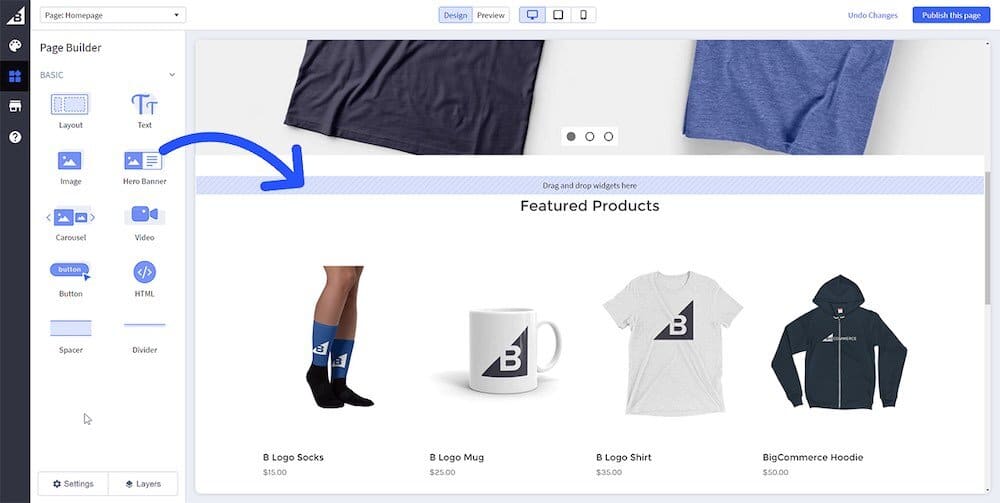
So in general, I’ve found BigCommerce easy to use and get started with — certainly when it comes to managing products and catalogs, it definitely stands up well in terms of usability by comparison to Shopify and Squarespace, and it beats Volusion hands down.
However, when it comes to managing content and layout, there is room for improvement.
This is chiefly because despite the welcome addition of the page builder, it’s not as easy to change the layout of a BigCommerce page as it should be — some elements are hard to remove or hide, and as mentioned above, changing fonts is not as easy as it should be (the default range provided with the free templates is fairly limited).
Additionally, content created using the page builder can only make use of the web fonts that come with your chosen BigCommerce template — custom fonts can’t be applied to any of the standard BigCommerce ‘widgets.’ As we’ve seen above, BigCommerce templates only give you access to a very small number of fonts, so if you’re particularly fussy about typeface selection, this situation isn’t ideal.
And, whilst the page builder is a potentially useful new development, there is scope to implement it slightly better.
You can only access the page builder if you go to the theme customizer — if you navigate to the web page you want to edit in the BigCommerce back end, you arrive at a rather old-fashioned WYSIWYG (what-you-see-is-what-you-get) editor. This is a bit confusing.
BigCommerce SEO features
A key concern of prospective BigCommerce users will be how good the search engine optimization (SEO) features in the platform are. An online store is nothing without organic traffic.
The good news is that SEO tools in BigCommerce are strong.
All the basics are covered nicely — it is easy to edit BigCommerce page titles, meta descriptions and headers.
You can also create and change product-specific URLs without difficulty, and, unlike some competing products (notably Shopify and Squaresapce), you can create short URLs (i.e., yourdomain.com/product-name instead of yourdomain.com/products/product-name), which is generally considered better for an SEO point of view.
Additionally, BigCommerce is no slouch when it comes to how a site performs on mobile. (This is crucial now that Google has introduced a ‘mobile first‘ approach to indexing content).
Not only are BigCommerce’s templates all responsive (meaning they are designed to adjust to suit the device they’re being viewed on – mobile, tablet, desktop etc.) but many also work as ‘Accelerated Mobile Pages’ (AMP), which can have some positive SEO implications.
Let’s drill down into AMP for a moment, as it’s an area that BigCommerce arguably leads the online store builder field in.
Using Accelerated Mobile Pages (AMP) in BigCommerce
Accelerated Mobile Pages (AMP) is a Google-backed project which aims to deliver your site content extremely quickly to mobile users, mainly by creating streamlined pages that strip out certain types of code (scripts) and features (for example, blog comments).
The main advantage of using AMP on your site is that it drastically reduces the number of mobile users who leave your site as a result of your content loading too slowly. This means you’ll get a higher percentage of engaged visitors, and potentially sales.
AMP format can also provide some SEO benefits too — many SEO experts believe that pages with a low drop-off rate that people ‘dwell on’ for some time (two things that AMP can deliver) are rewarded by Google’s algorithms in search results.Enabling AMP in BigCommerce just involves ticking a checkbox
At the moment, AMP format is typically used for blog posts and news articles — but it can also be used for other page types, including product pages on ecommerce sites.
(The fact that eBay was one of the early adopters of AMP format in the ecommerce world highlights that there are definitely some obvious benefits to using it in an online store context!)
BigCommerce’s AMP offering is excellent — its free templates facilitate AMP, and many of the premium themes do too.
Image optimization
Images that are sized correctly for the device they’re on and load quickly can improve page speed significantly — with faster-loading pages being given preferential treatment by Google in search results.
The good news is that BigCommerce does all this image optimization for you automatically.
All in all, I’m very impressed with BigCommerce’s SEO capabilities. In order to ensure your store ranks highly in search results, you will of course still need to engage in keyword research and link building — but the out-of-the-box technical SEO features provided by BigCommerce are very strong.
Related content: see see our Semrush review, our Ahrefs vs Semrush comparison and our post on Semrush pricing for more information on the additional tools you will usually need to help your online store rank in search results.
Blogging in BigCommerce
You might think that a blog is not an essential feature of an online store — but you’d be wrong!
Blogging is a key part of any successful inbound marketing campaign; when done well it can improve a site’s SEO and, by extension, traffic to it (with both improvements obviously leading to increased sales!).
Helpfully, there is a built-in blog in BigCommerce. Whilst it’s not going to compete with a WordPress blog in terms of functionality, it will nonetheless allow you to create the sort of posts that can attract visitors to your site.
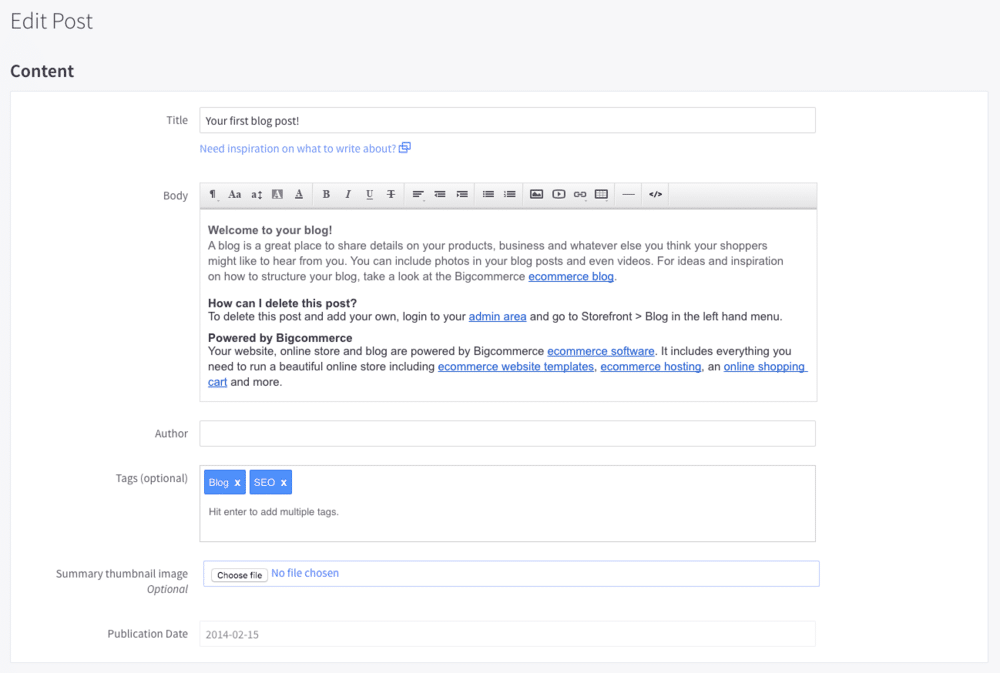
There is one rather strange omission from BigCommerce’s blogging functionality however: an RSS feed.
RSS feeds are useful because they allow your blog content to ‘travel’ — site visitors can use them to subscribe to new posts via RSS readers or embed your posts on other websites; and site owners can use them to automatically populate the newsletters sent by email marketing tools like GetResponse, Campaign Monitor, AWeber or Mailchimp.
If you feel the BigCommerce blogging functionality is not up to scratch, or if RSS is a deal-breaker for you, you can always integrate another blogging tool (such as WordPress) with your BigCommerce store.
It’s important to set this up correctly however — using a subdomain — as doing this incorrectly means that you may not benefit from the SEO / inbound marketing advantages that good blogging can bring.
Email marketing — a missing feature?
Something that’s provided by leading competitors — but is currently missing from BigCommerce’s feature set — is email marketing.
Unlike Wix, Shopify and Squarespace, BigCommerce doesn’t yet provide you with a way to host a mailing list and send e-newsletters out of the box.
However, integrations are available for BigCommerce with most of the leading email marketing solutions (AWeber and GetResponse etc.) — and these tend to provide a LOT more functionality than the built-in email marketing tools provided by online store builders.
BigCommerce analytics and reporting
BigCommerce provides users with several reports as standard, including:
customer reports (where your customers come from, the percentage of new vs returning customers, their overall spend and when they last made an order)
marketing reports (how you acquired your customers)
search data reports (the queries customers used when searching for products in your online store)
finance reports (sales, tax reports etc.)
abandoned cart reports (assuming your plan supports this feature).
For an additional fee you can also gain access to an ‘Ecommerce Insights’ report, which provides you with more detailed information on your customers, products and abandoned carts.
This fee varies according to the plan you are on — ‘Standard’ and ‘Plus’ customers can avail of ‘Insights’ for an additional $49 per month; for ‘Pro’ customers it’s $99 per month; and for ‘Enterprise’ customers it’s $249 per month.
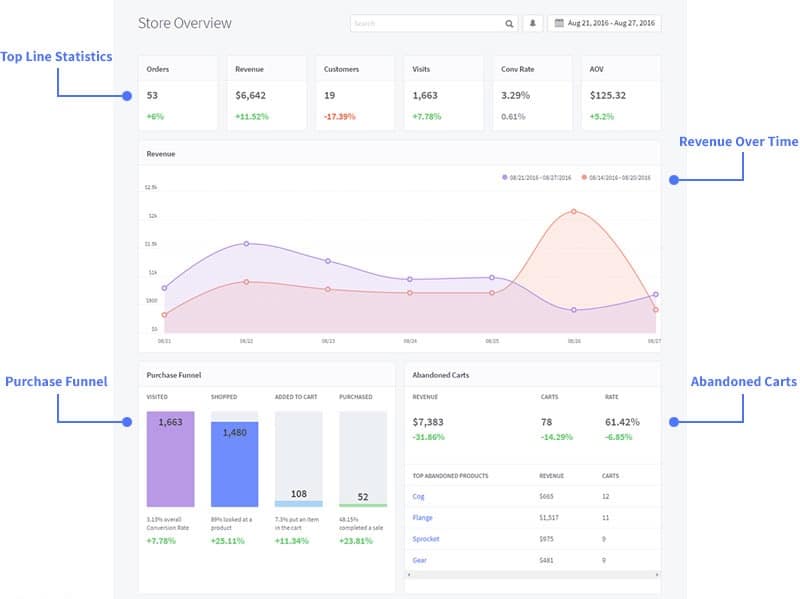
In short, the BigCommerce analytics offering is pretty strong — and the best thing about it is that the bulk of the reporting functionality comes as standard on all plans.
This is not the case with its key competitor Shopify, which requires you to be on its more expensive $79 plan before you get access to its more in-depth sales and customer reports.
Of course, in addition to using the built-in BigCommerce reporting tools, you could also supplement your analytics arsenal by integrating Google Analytics into your site and using goals to measure conversions.
iOS and Android apps for BigCommerce
After several years without a mobile app available, the good news is that BigCommerce has reintroduced one.
Available for both Android and iOS, the new app allows you to manage your store on the go. It allows you to:
access all your stores with one login
check your store’s revenue, orders, visitors, and conversion rate by week or by month
view and search your store’s orders, access individual order details, and update order status
view and search all your store’s customers, access individual customer details (including order history)
contact customers via in-app phone and email links.
The reviews for this app were initially quite poor, but BigCommerce seems to have fixed some key bugs and it’s receiving quite a positive reaction from users now. The iOS version seems to be generating higher ratings than the Android one, however (4.6 out of 5 versus 3.7 out of 5, respectively).
GDPR compliance in BigCommerce
With the introduction of GDPR (General Data Protection Regulation), there are several legal steps that website owners now need to take to ensure that they are adequately protecting their EU visitors’ privacy.
There are serious financial penalties for not doing so; and even if your business is not based in the EU, you still need to comply with the regulations where any site visits from the EU are concerned.
Now, please note that I’m not a lawyer and you shouldn’t treat anything here as legal advice; but that said, I’m going to spell out how I see GDPR issues affecting potential BigCommerce store owners.
Based on my understanding of the GDPR rules, the key things that BigCommerce store owners have to do are:
provide adequate privacy and cookie notices
process and store data securely
get clear consent from people signing up to mailing lists that it is okay to send them e-newsletters
provide a means to opt in or revoke consent to use of non-essential cookies on a website before they are run(and to log that consent).
It’s generally easy on most platforms to meet the first three requirements, although you will need to spend a bit of time (and possibly money on lawyers or legal templates!) creating the relevant notices and tweaking data capture forms in order to make them GDPR compliant.
The cookie consent requirement is harder to meet — but the good news is that unlike many competing platforms, BigCommerce actually does pretty well in terms of helping you do so.
To ensure GDPR compliance in this area, you are required to display a cookie banner to your website users that:
allows them to choose which cookies they want to run BEFORE those cookies are run (i.e., to give ‘prior consent’)
logs their consent to run cookies
allows them to revoke consent at a later stage.
So for example, if you use a Facebook Ads or Google Analytics cookie on your BigCommerce store, you will be breaking GDPR laws unless you have a solution in place which does all of the above.
Helpfully, BigCommerce provides a really straightforward way to add third-party scripts and ensure they are only run when consent is granted.
(It’s not clear however how to log user consent / facilitate revoking of it down the line — so there’s scope for improvement here).
GDPR cookie consent functionality, in my view, should always be considered a ‘core feature’ and not something that users should have to look to an app to provide — so it’s great to see that this feature, or at least the key parts of it, are provided out of the box by BigCommerce.
BigCommerce customer support
When you start a BigCommerce free trial, you are provided with various support emails and resources aimed at helping you with the ‘onboarding’ process.
There’s a fair amount of hand-holding available if you want it, which should make it easy enough to get your store up and running.
For those who have purchased a BigCommerce plan, the company provides 24-hour ‘live agent’ customer support (via phone, email or chat).
Before you get access to relevant contact details however, you are encouraged to try to resolve the issue by searching for an answer to your query via the BigCommerce help pages first (see screengrab below).
This will annoy some users a bit, although you do get presented with fairly easy-to-digest contact details once you’ve completed your search and ignored the help articles!
You can also use ‘skip this step’ button to bypass this — this immediately brings up the phone numbers, live chat options etc.
And of course the good news is that phone support is available for a wide range of countries — and if you don’t see your country listed, there’s a helpful ‘all other countries’ number you can call.
For those who are more inclined towards trying to sort support issues out themselves, there is a large range of video and text resources available from BigCommerce, and a community forum.
And finally a note on the languages that customer support is available in: you can currently access it in Dutch, English, French, German, Italian and Spanish.
BigCommerce review: conclusion
Ultimately, BigCommerce is one of the most feature-packed hosted online store builders I’ve tested — in particular, its entry-level plan provides significantly more ‘bang for the buck’ than many competing products. It’s strong on the SEO front, with AMP functionality and automatic image optimization features being provided out of the box. Its multi-currency selling functionality is really good too — and one of the strongest arguments for using this product over a competing one.
The main thing that needs improvement in BigCommerce would probably be its template selection — I think the free options provided could be more varied, they’re not quite as editable as they should be, and it would be better if they give you access to a wider range of web fonts.
I hope this BigCommerce review has helped give you a sense of this product and whether it’s suitable for your needs — but as usual, it’s always best to try before you buy, and you can avail of a free BigCommerce trial here.
Finally, below you will find my summary of the key pros and cons of BigCommerce.


.png)





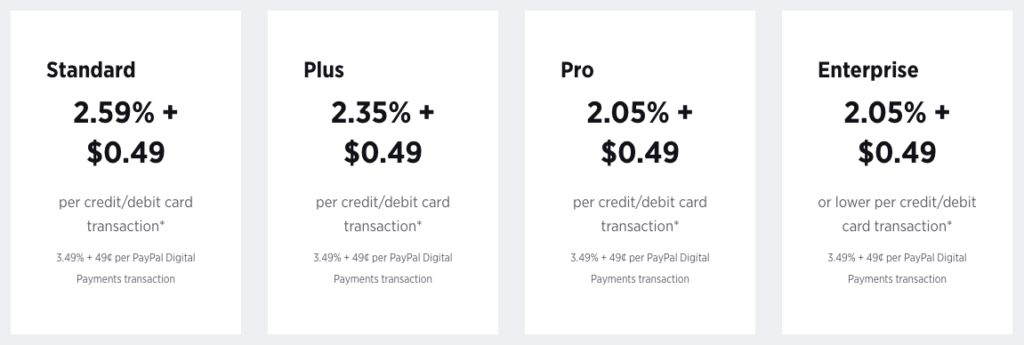

.jpg)


